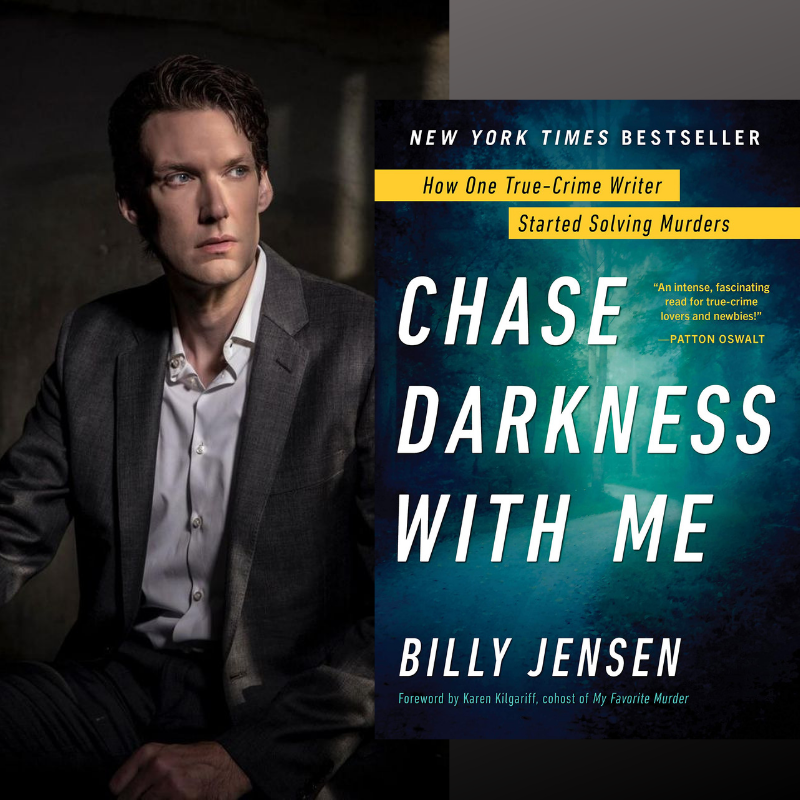Investigative journalist Billy Jensen has heavily impacted the true crime world with his deep-dive articles, podcasts, (he’s one half of the Murder Squad podcast with Paul Holes and a third of The First Degree podcast team with true crime producer Alexis Linkletter and LadyGang gal Jac Vanek), and now with his new book, Chase Darkness With Me.
The book has garnered rave reviews on Amazon and GoodReads so far, which makes sense because it delves into Jensen’s beginnings as a true crime reporter, (fun fact, he started out writing about his other passion, hockey) and it also contains a how-to guide on becoming a citizen detective—crowd-sourcing unsolved crimes using the internet to uncover new clues and even solve cold cases (which he’s done almost a dozen times now).
Jensen started out working as a “stringer” for the New York Times on weekends, meaning he wasn’t a regular part of the newspaper’s staff, but he filled in when they needed help. He found himself mostly covering oddball crime stories in Long Island until his first big break.
“I caught my first murder… I got a phone call that a body was found in a barrel inside a house that somebody had just moved into, so that’s where it started,” said Jensen.
If this case already sounds familiar, it’s because it was highly reported on in the New York Times and in publications all over the world.
“I talked to the neighbors and talked to the people that used to own the house before it was sold, and then I called up the original owner and said, ‘Is this Mr. Howard Elkins?’”
Jensen told Elkins about the pregnant woman’s body found in a steel barrel inside the crawl space of the home. Elkins denied knowing anything about the body, but a week later, he committed suicide. DNA later linked him to the unborn child.
It turned out that Elkins had killed his 28-year-old pregnant lover and then put her body in a steel barrel before filling it up with a chemical substance used to absorb industrial spills. He moved his wife and three children to Florida and for 30 years, the heavy barrel stayed in the crawl space.
“In my first-ever murder story, I ended up talking to the killer,” said Jensen.
His most memorable murder?
“It was probably the first one I solved, which was the case of Marques Gaines.” Gaines was punched in the face, fell back onto a busy Chicago street, and was run over by a taxi and killed.
Jensen got to work on Facebook, creating a page to help get tips on the identity of the “River North Puncher.”
Jensen tracked the assailant to Minnesota and eventually contacted a detective through LinkedIn to help get the puncher arrested six months after Jensen had originally pinpointed him. Crowd solving cases can be a slow burn.
Growing up, Jensen was bitten by the true crime bug, mostly because his father read crime books and watched a lot of crime-based television.
“Crime was very much prevalent in our house. It was a regular suburban household... but we talked about crime a lot,” said Jensen.
Once his writing career picked up, Jensen started specializing in unsolved cases, which means he wrote many stories with no real succinct, satisfying endings that true crime lovers crave. He took the road less traveled and chose to hone in on cases that had gone stale. Jensen was there to hit the “refresh” button.
“I wrote a story about the only unsolved murder on in New York City on 9/11 for instance, and then after writing hundreds of those stories, I got fed up.”
He worked on the Bear Brook case, which has recently been turned into a compelling podcast and is very coincidentally also about four bodies found in steel barrels in Bear Brook State Park, New Hampshire.
“I’ve been working on Bear Brook for about four years now and that’s a big part of the book,” said Jensen. He also helped finish Michelle McNamara’s best-seller “I’ll Be Gone in the Dark,” which she was in the middle of writing before suddenly passing away in her sleep.
Both the Bear Brook and Golden State Killer cases are linked in that familial DNA was used to crack the cases that had been cold for years, and Jensen had a hand in it by introducing Golden State Killer detective Paul Holes to the lead investigator on the Bear Brooks case, who then told Holes about the familial DNA technique.
“When I found out about Michelle, I had just walked the woods of Bear Brook. Those two cases had always been linked in my mind,” said Jensen. “To learn they were connected in real life completely blew me away.”
In a genre where the same reel of serial killers tend to be glorified through their horrendous crimes, Jensen says one of his goals is to shift the narrative from the bad guys to the good guys.
“The problem with true crime is that it’s filled with super villains...Bundy, Gacy, Manson, Dahmer, Son of Sam. But you look at the superheroes and a lot of them are nameless and faceless,” said Jensen. “With Paul [Holes] there was a way to change that. I want someone to watch a press conference, see Paul Holes and say, ‘I want to be that guy.”
These days, Jensen is working on a new unsolved case and is searching for a former Marine named Raymond “RJ” McCleod, who brutally murdered his girlfriend, Krystal Mitchell in June of 2016.
To learn more about this case, check out one of the more recent episodes of Murder Squad here.

